
A | B | C | D | E | F | G | H | CH | I | J | K | L | M | N | O | P | Q | R | S | T | U | V | W | X | Y | Z | 0 | 1 | 2 | 3 | 4 | 5 | 6 | 7 | 8 | 9

The Tea Horse Road or Chamadao (simplified Chinese: 茶马道; traditional Chinese: 茶馬道), now generally referred to as the Ancient Tea Horse Road or Chamagudao (simplified Chinese: 茶马古道; traditional Chinese: 茶馬古道) was a network of caravan paths winding through the mountains of Sichuan, Yunnan and Tibet in Southwest China.[1] This was also a tea trade route. It is also sometimes referred to as the "Southern Silk Road" or "Southwest Silk Road."[2]
There are numerous surviving archaeological and monumental elements, including trails, bridges, way stations, market towns, palaces, staging posts, shrines and temples along the route.[3]
"Ancient Tea Horse Road" is a historical concept with a specific meaning. It refers to a major traffic road formed by the exchange of tea and horses between Han and Tibet from the Tang and Song Dynasties to the Republic of China.
Road classification
Shaanxi-Gansu Tea Horse Road
Shaanxi-Gansu Tea Horse Road (陕甘茶马古道) is the main road for tea in mainland China to travel west and exchange for horses. It is one of the main routes of the ancient Silk Road.[4]
Tanggu Road
Beginning in the Han dynasty, the Tanggu Road (蹚古道) was formed by Shaanxi merchants and the ancient tea-horse market in the southwest frontier. Since the government of the Ming and Qing dynasties imposed government control on tea sales, tea sales were divided into regions, and the most prosperous tea and horse trading market was in Kangding.[4]
Yunnan-Tibet Tea Horse Road
The Yunnan-Tibet Tea Horse Road (滇藏茶马古道) was formed in the late sixth century AD. It started from Yiwu and Pu'er in Xishuangbanna, the main tea producing area of Yunnan, and entered Tibet through today's Dali Bai Autonomous Prefecture, Lijiang City and Shangri-La, and went directly to Lhasa. Some were also re-exported from Tibet to India and Nepal, which was an important trade route between ancient China and South Asia.[4]
Sichuan-Tibet Tea Horse Road
The Ancient Sichuan-Tibet Tea-Horse Road (川藏茶马古道) is a part of the Shaanxi-Kangding-Tibet Tea-Horse Road. It starts from Ya'an, the tea producing area of Yazhou in the east, passes through Dajian Furnace (now Kangding), reaches Lhasa, Tibet in the west, and finally leads to Bhutan, Nepal and India. More than a thousand kilometres, it is an indispensable bridge and link between ancient Tibet and the mainland.[4]
History
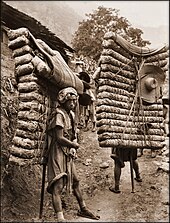
Sichuan and Yunnan are believed to be the first tea-producing regions in the world. The first records of tea cultivation suggest that tea was cultivated on Sichuan's Mount Mengding between Chengdu and Ya'an earlier than 65 BC. Ya'an has been an important hub of tea trading till the 20th century.[citation needed]
From around a thousand years ago, the Tea Horse Road become a trade link from Yunnan to Tibet; and to Central China via Sichuan Province.[4][5][6][7][8] It is believed that it was through this trading network that tea (typically tea bricks) first spread across China and Asia from its origins in Pu'er county in Yunnan.[9][10] The route earned the name because of the common trade of Tibetan ponies for Chinese tea, a practice dating back at least to the Song dynasty, when the sturdy horses were important for China to fight warring nomads in the north.[11]
Both people and horses carried heavy loads. Tea porters sometimes carried over 60–90 kg (132-198 lb.), which was often more than their own body weight in tea.[12][13][14] Porters were equipped with metal-tipped staffs, both for balance while walking and to help support the load while they rested, so they didn't need to lay the bales down (as illustrated in the photo).
In addition to tea, the mule caravans carried salt and silk products from Chengdu, notably shujin (蜀锦; a type of Sichuan embroidery).[citation needed].
Historic Site
The Ancient Tea Horse Road is a complex network of roads, of which some of the ancient tea horse roads and related historical sites in Sichuan, Yunnan and Guizhou provinces were listed as the seventh batch of China National Key Cultural Relics Protection Units[15] on 5 March 2013. There are numerous cultural heritage sites listed as National Key Cultural Heritage Protection Units, including ancient road sites, post stations, shops, pagodas, bridges and piers, as well as related guild buildings, religious buildings, mining and metallurgical sites and kiln sites, cliff carvings and inscriptions in the ancient tea horse road network.
In Sichuan
The Ancient Tea Horse Road in Sichuan.[16]
| Name | Location | positioning | Description | Picture | Signpost |
|---|---|---|---|---|---|
| In Chengdu | |||||
| Pingle Longshan ancient road | Pingle Town, Qionglai City | 30°20′12″N 103°20′10″E / 30.33667°N 103.33611°E | Located on the south side of Pingle Ancient Town, within the South Silk Road Ruins Scenic Area |  |

|
| Shuanmaling Ancient Road, Linje | Linji Town, Qionglai City | ||||
| Tiantai Mountain eart stream, Zijing Village ancient road | Tiantaishan Town, Qionglai City | 30°13′24″N 103°9′1″E / 30.22333°N 103.15028°E |  |

| |
| Jiaguan Gongdian Ancient Road | Jiaguan Town, Qionglai City | 30°15′19″N 103°13′34″E / 30.25528°N 103.22611°E |  |

| |
| Site of ancient fire (salt) well of oil press | Huojing Town, Qionglai City | 30°22′54″N 103°13′28″E / 30.38167°N 103.22444°E |  |
||
| Lining waist rock tea horse ancient road | Chaoyanghu Town, Pujiang County | 30°9′17.9″N 103°24′14.4″E / 30.154972°N 103.404000°E | The old stone pathway from the old pine tree on the top of the lined waist rock to the ancient pathway on the shore of Changtan Lake is 470 metres long. | 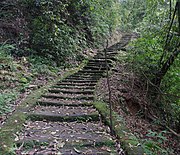 |

|
| Songmau Ancient Road (Lung Chi Section) | Longchi Town, Dujiangyan City | 31°3′46″N 103°32′4″E / 31.06278°N 103.53444°E |  |

| |
| In Zigong | |||||
| Lok Shan Square | Ziliujing District | ||||
| Huicaikou ancient salt Road | Ziliujing District |  |

| ||
| Mugye Beach Pier | Gongjin district | 29°21′17″N 104°40′53″E / 29.35472°N 104.68139°E | It consists of two piers, the upper and the lower, and the boat trough was dug in the 35th year of the Kangxi era (1696) and the Pingkang Weir Gate was built in the 30th year of the Guangxu era (1904). |  |

|
| Gong Jing Old Street salt Road | Gongjin district | ||||
| Salt Wharf in Xian Town | Yantan district | ||||
| In Luzhou | |||||
| Guangming Ancient Road | Fuji Town, Lu county | 29°07′23″N 105°24′29″E / 29.12306°N 105.40806°E | Located in Guangming Village, Fuzi Town, Lu County, it runs southeast–northwest, with an existing length of 1091m and a width of 1.7m~2.9m.[17] |  |

|
| Pauline Street Post Road | Longmatan district | It is 810 meters in length. |  |
||
| Shawan Post Road | Jiangyang district | ||||
| Fengming Post Road | Hejiang County | 28°42′48″N 105°52′50″E / 28.71333°N 105.88056°E |  |
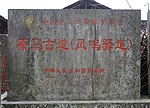
| |
| Bailu Post Road | Hejiang County | ||||
| Xiantan ancient post Road | Hejiang County | ||||
| Dashichuanqian post road | Xuyong county | ||||
| Monkey Ridge Chuanqian post road | Xuyong county | ||||
| Guandou Village Chuanqian post road | Xuyong county | ||||
| Chishui River tea horse post Road | Xuyong county | ||||
| Erlang Post Road | Gulin county | ||||
| In Ya'an | |||||
| Guanyin Tower | Yucheng district | 29°59′26.4″N 102°59′25.5″E / 29.990667°N 102.990417°E |  |

| |
| Jingju nunnery stone archway | Mingshan district | 30°4′33.5″N 103°3′13.9″E / 30.075972°N 103.053861°E |  |

| |
| Yu Palace | Mingshan district | 30°4′40.6″N 103°2′52.7″E / 30.077944°N 103.047972°E |  |

| |
| Ganlu Ling Quan courtyard stone archway | Mingshan district | 30°4′55.7″N 103°2′46.5″E / 30.082139°N 103.046250°E |  |

| |
| Imperial Tea Garden | Mingshan district | 30°4′59.8″N 103°2′45.8″E / 30.083278°N 103.046056°E |  |

| |
| Tianti ancient path | Mingshan district | 30°4′43.3″N 103°2′51.7″E / 30.078694°N 103.047694°E |  |

| |
| Ganxipo Tea horse ancient Road post site | Tianquan county | 30°05′25.6″N 102°41′44.3″E / 30.090444°N 102.695639°E |  |

| |
| Bian tea official warehouse | Tianquan county | 30°01′14.8″N 102°49′47.9″E / 30.020778°N 102.829972°E |  |

| |
| Feixian Pass and South Boundary Archway | Lushan county | 30°01′35.4″N 102°53′46.1″E / 30.026500°N 102.896139°E |  |

| |
| Saddle waist cliff inscription | Lushan county | ||||
| Rebuild the road monument of Daxiangling Bridge | Xingjing County | ||||
| The site of Gongxing Tea from the Qing dynasty | Xingjing County | 29°47′39.4″N 102°50′28.8″E / 29.794278°N 102.841333°E | Also known as the ginger family compound |  |
|
| Qingxi Pass Site of Tang dynasty | Hanyuan county | ||||
| Ruins of Qingxi ancient city in the Qing dynasty | Qingxi town, Hanyuan County |  |
|||
| Ruins of the 24 Daoguai Ancient Road | Hanyuan county | ||||
| Yangquanmen Ancient Road site | Qingxi town, Hanyuan County | 29°36′5″N 102°37′48″E / 29.60139°N 102.63000°E |  |
||
| In Aba | |||||
| Baizhangfang ancient plank road | Ganbao Township, Li County | It is found on the north bank of the Zaguzhi River near the Baodian Temple in Zaguzhi Township, Gambao Township, Li County |  |
||
| Stone carvings of Sui and Tang Dynasties in Putou Mountain | Putou Township, Li County | ||||
| Kegu Plank Road | Kegu Township, Wenchuan County | 31°30′9.1″N 103°34′17.1″E / 31.502528°N 103.571417°E | Located on the north bank of the Miscellaneous Valley Brain River in Keku Township, Wenchuan County, the surviving site is 158 metres long and 0.4–2 metres wide, including two Qing dynasty inscriptions. |  |

|
| Poyong ancient Road | Maerkang City | ||||
| In Ganzi | |||||
| Hualinping Tea Horse Ancient Road | Xinglong Town, Luding County | 29°42′55.9″N 102°18′14.6″E / 29.715528°N 102.304056°E |  |

| |
| Fo'er Cliff tea Horse ancient Road | Lengqian Town, Luding county | 29°46′28.2″N 102°13′40.1″E / 29.774500°N 102.227806°E |  |

| |
| Yingge Mouth Tea Horse Ancient Road | Batang County | 29°59′11″N 99°7′30″E / 29.98639°N 99.12500°E |  |
||
| In Liangshan | |||||
| Ganluo Qingxi Gorge ancient road | Pingba Township, Ganluo County | 29°08′07.0″N 102°34′37.5″E / 29.135278°N 102.577083°E |  |

| |
| Dingshan Bridge and Lingguan Inscriptions in Yuexi | Dingshan Township, Yuexi County | 28°35′49.0″N 102°29′48.8″E / 28.596944°N 102.496889°E |  |

| |
| Dengxiangying Ancient Post | Xide County | 28°27′59.0″N 102°20′38.1″E / 28.466389°N 102.343917°E |  |
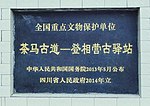
| |
| Xide Mianshan Camp site | Xiande County Mianshan Town | 28°22′31.8″N 102°19′40.5″E / 28.375500°N 102.327917°E |  |

| |
| Yalong River in Mianning, including | Mianning County | ||||
| Songpingguan | Huili County | ||||
In Yunnan
There are 86 cultural heritage sites on the ancient tea horse route in Yunnan province, located in 21 counties and cities[18]。
| Name | Location | Positioning | Description | Picture |
|---|---|---|---|---|
| In Xiangyun County | ||||
| Yunnanyi Ancient Road | Yunnanyi Town, Xiangyun County | 25°25′29″N 100°41′26″E / 25.4248°N 100.6905°E | 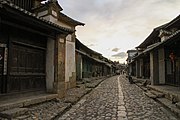
| |
| Xiaoshao to Huangcaoshao Ancient Road | Midian Town, Xiangyun County | |||
| Baisha Slope to Yongan Bridge ancient road | Midian Town, Xiangyun County | |||
| Tiger Pass to Puchang River section of the ancient post road | Midian Town, Xiangyun County | |||
| Xincun to Binchuan south boundary monument section of ancient post road | Xiangyun Town, Xiangyun County | |||
| Zhenyang Gate | Gulou East Street, Xiangcheng Town, Xiangyun County | 25°28′45″N 100°33′34″E / 25.47926°N 100.55950°E | 
| |
| Yangbi section[19] | ||||
| Dahe River street section | Dahejiang Village, Pingpo Village Committee, Pingpo town, Yangbi | Total length 240 meters | ||
| Liziyuan to the dam field section | Liziyuan Village, Pingpo Village Committee, Pingpo town, Yangbi |
Zdroj:https://en.wikipedia.org?pojem=Tea_Horse_Road Text je dostupný za podmienok Creative Commons Attribution/Share-Alike License 3.0 Unported; prípadne za ďalších podmienok. Podrobnejšie informácie nájdete na stránke Podmienky použitia.
Analytika
Antropológia Aplikované vedy Bibliometria Dejiny vedy Encyklopédie Filozofia vedy Forenzné vedy Humanitné vedy Knižničná veda Kryogenika Kryptológia Kulturológia Literárna veda Medzidisciplinárne oblasti Metódy kvantitatívnej analýzy Metavedy Metodika Text je dostupný za podmienok Creative
Commons Attribution/Share-Alike License 3.0 Unported; prípadne za ďalších
podmienok. www.astronomia.sk | www.biologia.sk | www.botanika.sk | www.dejiny.sk | www.economy.sk | www.elektrotechnika.sk | www.estetika.sk | www.farmakologia.sk | www.filozofia.sk | Fyzika | www.futurologia.sk | www.genetika.sk | www.chemia.sk | www.lingvistika.sk | www.politologia.sk | www.psychologia.sk | www.sexuologia.sk | www.sociologia.sk | www.veda.sk I www.zoologia.sk | ||




